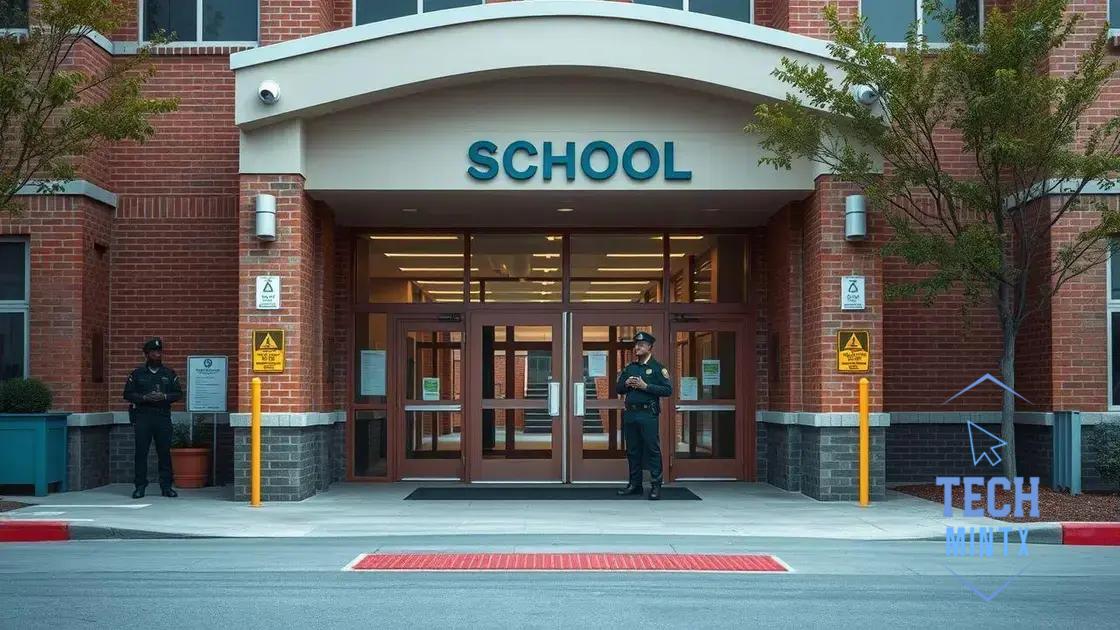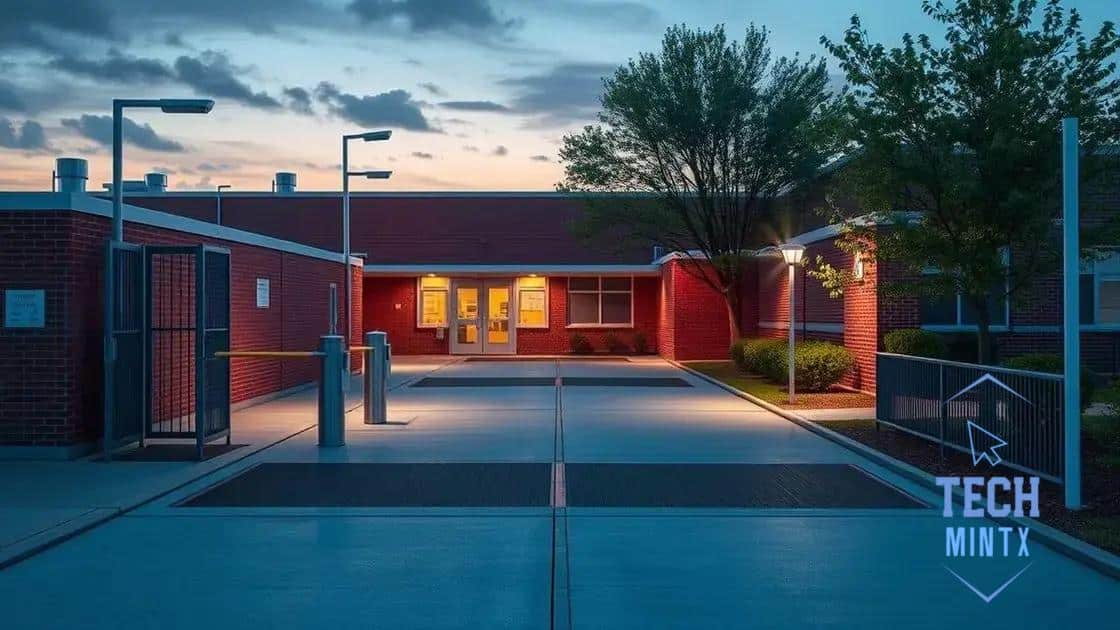Federal funds support school security upgrades for safety

Federal funds support school security upgrades by providing essential resources for advanced security systems, ensuring safer environments for students and staff through various funding mechanisms and community engagement.
Federal funds support school security upgrades, enhancing the safety of students across the nation. Have you ever wondered how these funds are transforming schools into safer havens for learning? Let’s dive deeper into the impact of this initiative.
Overview of federal funding for school security
Understanding the overview of federal funding for school security is essential to grasp how these financial resources are allocated and utilized. This funding plays a critical role in enhancing the safety of educational environments nationwide. Over recent years, schools have recognized the need for improved security measures, leading to significant investments.
Federal funding guidelines help schools implement specific security upgrades. These guidelines ensure that the funds are used efficiently to protect students and staff. Security measures can include state-of-the-art surveillance systems, controlled access points, and emergency response protocols.
Key components of federal funding
To better understand how federal funding contributes to school safety, it’s important to know its core components. Funding does not simply provide cash; it also outlines how the money can be used effectively.
- Funding sources include federal grants and programs.
- Grants often require matching funds from state or local resources.
- Detailed plans must be submitted to qualify for funding.
- Continuous assessment of security needs is vital for effective spending.
Through these components, schools can identify the most pressing security concerns. Responding to these needs enables schools to create safer spaces for learning. The process of applying for federal funding requires careful preparation and strategic planning. Schools must align their security initiatives with the criteria set forth by federal entities.
Applications of federal funding
Once federal funds are obtained, schools can begin to transform their safety infrastructure. The allocation of these funds supports various essential upgrades. Typical applications of federal funds for school security include:
- Installation of surveillance cameras.
- Improving lighting in and around school buildings.
- Upgrading access control systems to monitor who enters the school.
- Conducting safety drills and training programs for staff and students.
These implementations not only protect the physical environment but also promote a sense of security among the student body. As schools continue to develop their safety measures, it becomes clear that federal funding is a cornerstone of these advancements. Schools are now focusing on integrating technology with traditional security practices. This blend elevates the safety standards and offers peace of mind to parents and staff alike. The ongoing commitment to enhancing school security remains a top priority, ensuring that learning environments remain safe and conducive to education.
Importance of upgrading security systems

Understanding the importance of upgrading security systems in schools is vital for creating a safe learning environment. As crime rates in some areas increase, older security measures may no longer be effective. Upgrading systems ensures that schools can adapt to new threats and technologies.
Modern security systems incorporate advanced technology, which helps protect students and staff. With better tools, schools can respond faster to emergencies and minimize risks. For instance, installing surveillance cameras at key points allows for real-time monitoring and quick reactions to incidents.
Key benefits of upgrading security systems
When schools invest in new security technology, several benefits emerge:
- Enhanced safety: Modern systems provide improved protection against potential threats.
- Better emergency response: Upgraded systems enable faster communication during crises.
- Increased confidence: Students, parents, and staff feel safer in a well-protected environment.
- Integration with other technologies: New systems often work with other safety protocols.
Furthermore, updated systems can significantly lower the chances of incidents occurring. Having modern tools helps deter unwanted behavior and enhances the overall school atmosphere. The presence of adequate security measures can be reassuring for everyone involved in the educational process.
Examples of essential upgrades
Schools should consider various security upgrades to stay ahead of potential risks. Some critical upgrades include:
- Installing access control systems to limit building entry.
- Upgrading alarm systems for better detection of unauthorized intrusions.
- Enhancing lighting around the campus to ensure visibility during nighttime.
- Implementing emergency communication systems for quick notifications in case of threats.
With these essential upgrades, schools not only increase their safety but also foster a learning environment where students can thrive. Ultimately, the importance of upgrading security systems cannot be overstated. Enhanced security measures allow educational institutions to focus on what matters most—educating students in a safe, nurturing environment.
Case studies: successful funding implementations
Examining case studies of successful funding implementations provides valuable insights into how schools effectively use federal funding to enhance security. These real-world examples show the practical application of funds and the positive outcomes that can result.
One notable example is a high school in Texas that utilized federal grants to install a comprehensive security system. They focused on integrating advanced surveillance cameras and access control measures. As a result, the school saw a significant decrease in unauthorized entries and increased overall safety, which helped to foster a more secure learning environment.
Key elements of successful implementations
Successful funding implementations often share common characteristics that contribute to their effectiveness:
- Clear objectives: Schools must outline specific goals for their security upgrades.
- Community involvement: Engaging parents and local organizations can lead to better support and more tailored solutions.
- Regular assessment: Ongoing evaluations of security measures ensure they meet current needs.
- Training programs: Providing staff with training on new systems enhances their effectiveness.
Another case study comes from a district in California that received federal funding to upgrade their alarming and notification systems. By modernizing these systems, they improved communication during emergencies, allowing for quicker responses. This upgrade not only helped in actual crisis situations but also reassured parents and guardians about the safety of their children.
Impact on the school community
In both cases, the upgraded systems created a profound impact on the school community. Students reported feeling safer, and teachers were able to focus more on teaching without having to worry about safety issues. The successful use of federal funds allowed these schools to shift their focus back to education instead of constantly managing security concerns.
As schools continue to implement these changes, they inspire others to pursue similar upgrades, showing that with proper planning and the right resources, safety can be significantly enhanced. The case studies of successful funding implementations not only highlight the capabilities of funded initiatives but also serve as models for other schools looking to improve their security infrastructure.
Challenges faced during upgrades

Upgrading security systems in schools brings numerous benefits, but it also presents several challenges faced during upgrades. Understanding these obstacles is crucial for effective planning and implementation.
One major challenge is securing funding within tight budgets. Even with federal support, schools often need to find additional resources to cover the full costs of upgrades. This can create delays and limit the scope of the improvements.
Common obstacles in the upgrade process
There are specific challenges schools regularly encounter during security system upgrades:
- Lack of technical expertise: Many schools may not have staff with the required knowledge to choose and implement new systems effectively.
- Resistance to change: Some staff members and parents may be hesitant about new security measures, fearing they might disrupt school operations.
- Integration issues: New systems must work well with existing technology, which can be a complex task.
- Compliance with regulations: Schools must adhere to various local and federal regulations relating to safety and privacy, which can hinder implementation.
Addressing these challenges requires thoughtful strategies. For instance, schools can engage with local law enforcement and security experts for guidance during the upgrade process. Training staff on new systems helps ensure everyone is comfortable with the changes. Additionally, involving the school community—parents, teachers, and students—in the discussion can help alleviate concerns about the upgrades.
Balancing security needs with educational priorities
As schools navigate the challenges of upgrading security systems, it is essential to maintain a balance between safety measures and educational priorities. Staff and students might feel overwhelmed by excessive security. Hence, finding the right level of security without compromising the open and welcoming school environment is key. Decisions on upgrades should align with the overall goals of the school, ensuring that the improvements not only enhance safety but also support learning.
Through careful planning and community involvement, schools can overcome these challenges, paving the way for a safer and more secure learning environment. The challenges faced during upgrades highlight the need for collaboration, clear communication, and a strong focus on educational objectives. This holistic approach will ultimately lead to more successful implementations of security enhancements.
Future of school security funding initiatives
The future of school security funding initiatives holds great promise as safety becomes a top priority for educational institutions. As communities recognize the importance of a secure learning environment, more programs are being developed to address this need.
One of the key trends is the increasing collaboration between federal, state, and local governments. This partnership is essential for maximizing funding opportunities and ensuring that resources are allocated effectively. Schools are now better positioned to access a wider range of funding sources, which can be crucial for implementing comprehensive security measures.
Innovative funding sources
Looking ahead, schools will likely benefit from innovative funding mechanisms:
- Public-private partnerships: Collaborations with private companies can provide additional resources and expertise.
- Crowdfunding: Many schools are turning to community members for support, raising funds directly through online platforms.
- Grant programs: Increased availability of grants specifically targeting school safety initiatives is expected.
- Technology-focused funds: As technology evolves, funds dedicated to upgrading security tech will become more prominent.
These funding sources not only offer financial support but also encourage schools to engage their communities in the conversation about safety. Involving parents, students, and local organizations fosters a stronger sense of shared responsibility regarding student safety.
Emphasis on comprehensive strategies
The future will also see a shift towards comprehensive safety strategies. Rather than simply investing in physical security measures, schools will focus on creating well-rounded safety programs that include behavioral assessments, mental health resources, and crisis management plans. This holistic approach meets the needs of the entire school community.
Moreover, as technology continues to advance, schools will increasingly incorporate smart systems, such as AI-driven surveillance and communication tools. These innovations will enable quicker response times and more effective monitoring capabilities. Keeping up with the latest in security technology is crucial for enhancing school safety.
To prepare for the future, schools must remain flexible and proactive. Engaging in ongoing training for staff and students will be essential as new protocols and technologies emerge. The future of school security funding initiatives promises a safer and more inclusive educational experience for all, helping to create environments where students can learn without fear.
In conclusion, the journey toward enhancing school security is driven by a commitment to creating safe learning environments for all students. With federal funding, schools can implement vital upgrades that address unique security needs. While schools face challenges during upgrades, engaging the community and adopting innovative strategies can lead to meaningful improvements. As technology evolves, schools will continue to adapt and prepare for a safe future. By prioritizing safety and involving all stakeholders, we can foster educational spaces where students thrive without fear.
FAQ – Frequently Asked Questions about School Security Funding
What types of funding are available for school security upgrades?
Schools can access federal grants, state funds, public-private partnerships, and community crowdfunding to support security upgrades.
How can schools engage the community in safety discussions?
Schools can hold meetings, send surveys, and create forums for parents, students, and community members to share their concerns and ideas about safety.
What are the main benefits of upgrading school security systems?
Upgrading security systems enhances safety, improves emergency responses, increases stakeholder confidence, and integrates new technologies for better monitoring.
What challenges do schools face during security upgrades?
Common challenges include budget constraints, resistance to change, technical expertise shortages, and compliance with safety regulations.





